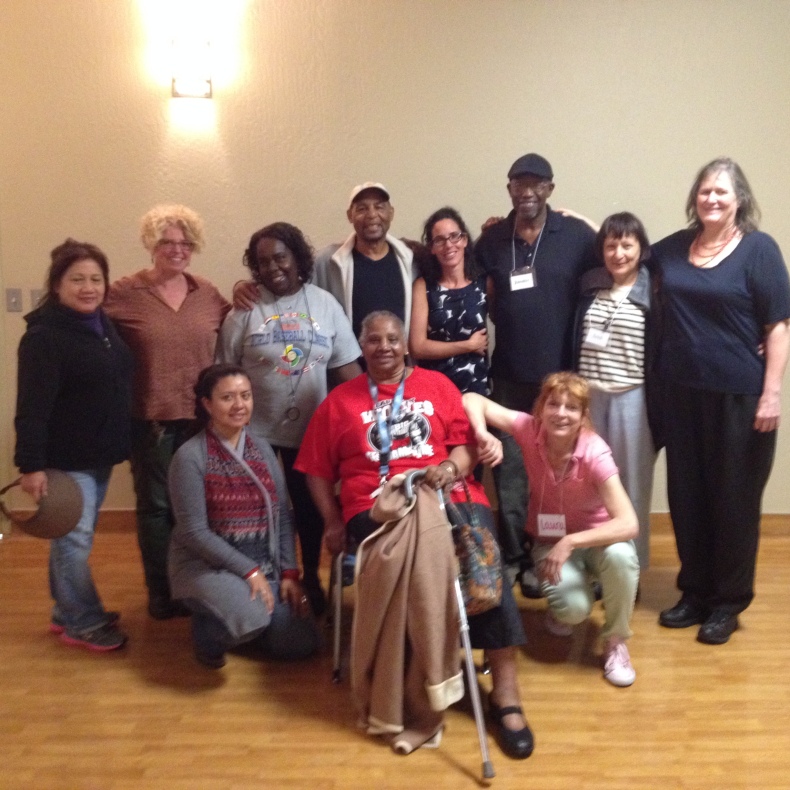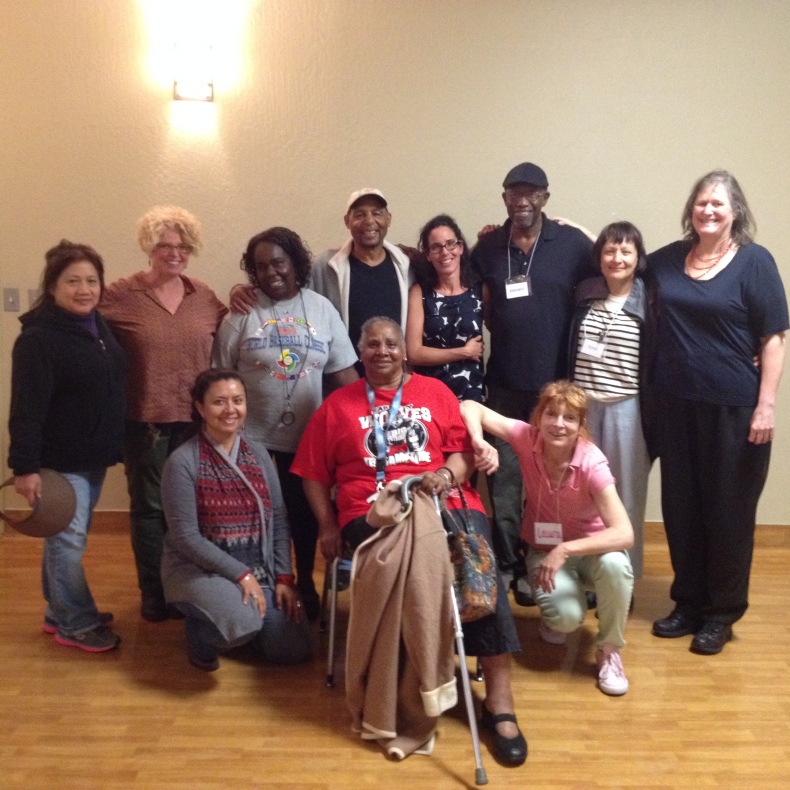SFGH – CARE group
I catch the 14 bus to the Mission District, 20th street. Great to be recognising landmarks, and areas. I get off near by Ruth’s Table and walk 10 or so blocks east towards the Hospital (SFGH). Away from the busier commercial streets, I am walking through a residential area. As always, I am drawn to the lush greenery everywhere, and in particular, my favourite plants – black eyed susan and bougainvillaea – here in cascades. Again, mature lemon trees, orange trees. Lovely houses, bay fronted, painted colourfully, this looks a lovely neighbourhood.
The hospital entrance is under construction, but I find my way through the dust (wandered into the building site by mistake – much to their amusement) and then through corridors up to the second floor. As I step out of the lift, I can hear Bollywood music – walking towards that sound I arrive at the Wellness Centre. I hover at the open door for a while – I’m still a bit early – watching a very fit instructor roll his hips very smoothly, and watching the staff keeping up. Helpfully a staff member approaches and tells me I have to go through the dance class to get to the office.
I am greeted warmly with a big hug by Blue. Blue Walcer is the director of the CARE (Cancer Awareness, Resources and Education) and a Wellness Innovator. She and I have been corresponding for almost a year now, and it is wonderful to meet her in person. I also meet Nasrin Aboudamous, Community Wellnes Program Coordinator, and Sylvia Romero-Pagan, who helps run the CARE program.
CARE has been running for 15 years – when the Wellness Program was initiated three years ago, Blue was asked to step into the new programme and help develop it, given her rich experience with CARE. The group I am coming to meet is the support group for patients who have cancer, or who are in remission. Blue had asked if I would give a movement session with her group – introduce them to the practice of expressive movement. We have an hour and a half to talk before the group begins. Blue begins by showing my a workshop she is finalising for tomorrow. A ward manager has asked Blue to come in and work with his nurses who are experiencing high level of burnout. Blue has devised a workshop that is playful, is about having fun, building team comraderie, and very carefully explores issues around motivation, satisfaction, personal fulfilment – she explains that it is important for the nurses to have some time away, to enjoy themselves, and to begin to think about where their job satisfaction lies in regard to life achievements and goals, hobbies and interests. Its a time for them to remember themselves as people, and think about how to re-engage in their work with more personal satisfaction.
We talk about the hospital. Its a public health hospital. SFGH caters to the whole of the Bay area – and it caters to those who have no health insurance, who have no network of support. SFGH also caters to all the undocumented immigrants who the Obama care program misses. It is a vast machine, with a huge staff population. It has the main, huge, sprawling hospital, and then many community outposts. We talk of many issues, but will share only a few to provide some context.
The Wellness program was established for patients, for staff, and for the wider San Francisco community. Its aims are to “improve the health and wellness of SFGH patients and community members by fostering a holistic sense of health and increased community cohesion”. There are different components to the Wellness program; the Active Living Initiative incorporates the movement classes.
A core weave through the program is the adaptation of classes and programs to the rich cultural and ethnic diversity of patients and staff. Most class instructors are bilingual in English/Spanish or English/Cantonese. There are many movement programs and dance classes on offer – Bollywood, African/Brazilian, Zumba, Yoga, Strength Training, Mindful Meditation, Hip hop, Salsa…All classes are free. Nasrin explains that the dance class program was initially developed with ODC – the dance school, who gave advice on the type of classes to offer; many of the instructors are teachers at the dance school. When I ask whether there were any reservations abut offering dance to staff and patients, Blue answers that it was felt to be an obvious way of promoting the Active Living initiative. The classes are popular with the staff – its a huge staff population and enough people come along. I need to ask about patient uptake.
Massage is also offered – on the wards, in the staff rooms – 10 minutes at a time, and it is very popular.
Blue tells me that people like to learn in community. They come to classes as much for the group support as for the activity benefits. She tells me the SFGH population range is extreme in width and depth – some people have university degrees, but decided to become artists, so are poor, others are not just immigrants, but refugees who have experienced traumatic life experiences. There are people who are generationally poor – locked into housing project poverty. Different communities view the classes differently. Blue tells me, “For the CARE group, there are three groups – one in English, one in Spanish, one in Chinese. The Chinese group refer to the program as ‘the lectures’. The Spanish group refers to the program as ‘la reunina’ -the get together, and the English group refers to the program as the dinners.” Blue continues…”What’s very sad and distinct about the English speaking community here is they are profoundly socially isolated – people who don’t have any family, don’t have any close connections – once in the care group I asked people to identify your closest relationship, and about half the people named a social worker, or a social service provider.”
I am about to meet the English speaking CARE group. The group begins with a meal – a free meal – people are hungry, and the free meal is an essential component of the groups success. I go for my plate of food, and sit with Raymond, who tells me about his life. A great storyteller, his life span has covered the distance travelled through racial inequality – he tell me of the times where, as a black man, he could not walk down Market Street. Now, he says – it’s all different.
As people arrive and take their food – a very colourful and healthy meal, of course – they sit in twos or threes and catch up with each other.
Blue begins the group with “check in”. Each person is invited to say how they are, share their diagnosis if they wish, or pass. Most interestingly – all the men talk extensively about their feelings and pain, and their medical complications – whilst most of the women give very brief and succinct reports, several pass. At the end of each person, Blue warmly congratulates them for being there, for making it to the group, as well as reiterating some of her comments she makes during their testimonies, and the group awards warm applause. It takes some time to get round the group – it’s a large group of about 35 people.
As people share, other group members take up their story – offer advice, prayers, express their concern, communicate solidarity, and blessings. It is a hugely caring and supportive group. Again and again people say that without this group they could not manage their symptoms. Raymond tells me later that the group is his life line – it gives him the wherewithal to manage his disease, his pain, and his isolation within his family, who just don’t get it. Several times during the testimonies, Blue refers to the power of movement to help manage a sense of pain, and tells the group I will be telling them more about this shortly. She is gently introducing me to the group.
Then its my turn – to introduce myself, and to introduce Winston Churchill – who I have to say gets much approval and appreciation for his setting up of the Trust and its opportunities. And I begin the session. Some people are keen, some are looking a bit wary. Reserving judgement. I’m not feeling nervous because people are polite, and warm and welcoming to their English guest – but I really feel I want to get it right – I want to give them an opportunity to experience how movement can alleviate pain, can shift anxiety and frustration. Hearing the stories, I felt very moved by their experiences – it is so tough to be a patient without choices or much sense of control. There is a lot of pain and frustration and anxiety in the group. I have 45 minutes.
By the end of the session, we have two groups dancing and performing for each other. We end in a circle and take it in tuns to express and and send a gesture into the group. We have warmed up, we have brought our awareness to our breath and bodies, we have opened and stretched and shifted our bones, expanded our lungs and organs. We have created small intuitive and improvisatory duets, and we have choreographed in groups, and shared our pieces with each other. Of course it turns out this is a group that loves to move, loves to dance, know the words to the songs, and sing and clap along. The energy is high, there is a lot of laughter, and I think, pride, that in such a short time, such great dancing has been achieved.
The feedback forms reflect the sense of fun and wellbeing the participants reached. “I feel alive again” is one comment I read and remember. Sylvia is going to photocopy the feedback forms and send them to me. Wonderfully, the feedback forms have no words – just an image of a mind, a heart, and feet: I think…I feel… I will take forward. It’s important to evidence and document that groups are work and are effective; this is the nicest document form I have seen.
The cards are filled with warm words, and heart felt emotions.
Afterwards this group of generous people take the time to thank me, hug me, tell me they enjoyed it, and thank me again. I ask if we can take a group photo – (never my strength, asking for photographs), but those of them who haven’t left fall into the fun of a group photo easily. This is for your Churchill Trust! We place Pearl in the middle – and she becomes the group matriarch, the queen. Poses are held, and it all feels very regal.
I am treated to a ride home with Nancy and Syndi in a taxi. We talk of this and that, of life in San Francisco, which all agree, including Thomas the driver,is good.
Click here to submit a comment and click here to return to the blog.


